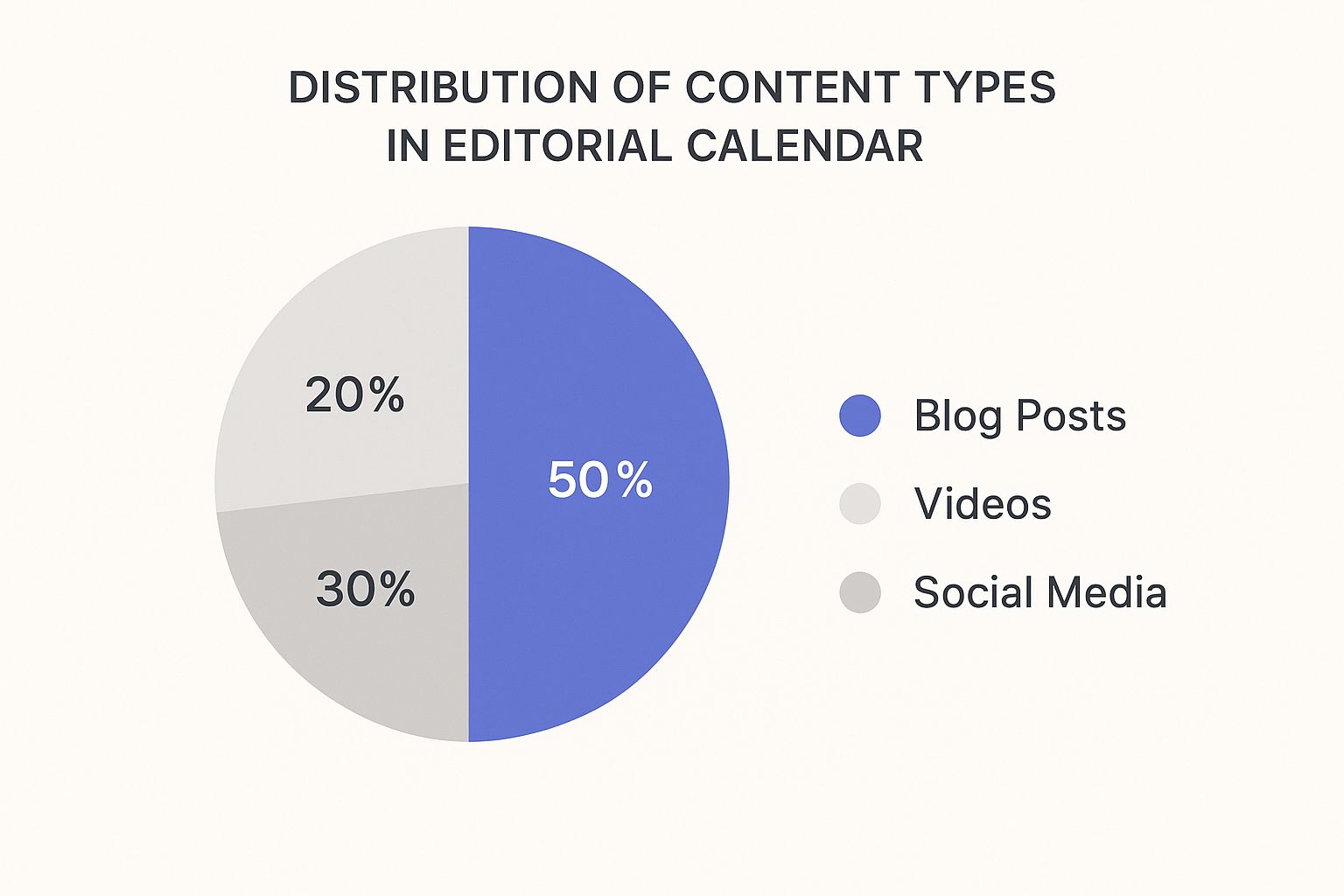Why Generic Content Strategy Templates Actually Hurt Your Results

Let's be real, snagging a random website content strategy template can feel like a quick win. But honestly, these generic templates can actually backfire. They look great on the surface, all organized and promising, but they rarely consider what makes your business unique.
It's like buying a one-size-fits-all suit. Sure, it covers you up, but it's not going to fit right, and it's definitely not going to show you off in the best light. Grasping the foundations of content strategy is key before you even think about templates.
The Problem With "One-Size-Fits-All"
Generic templates assume every customer follows the same path and that content creation is a standardized process. But your audience interacts with your content in its own way. For instance, a B2B SaaS company selling complex software has a totally different customer journey than an e-commerce shop selling handmade jewelry. Using the same template for both ignores the very real differences in buyer behavior and content needs.
This leads to wasted time and a big disconnect between your content and who you’re trying to reach.
Generic website content strategy templates also struggle to keep up with changing markets and business goals. What works today might be totally irrelevant tomorrow. A rigid template makes it hard to shift gears and adapt. You’re stuck with a plan that no longer works, like using an old map on a road trip - you might get there eventually, but you’ll run into a lot of unexpected roadblocks.
Plus, research shows that many marketers struggle to actually use their documented content strategies. The Content Marketing Institute found that only 29% of marketers with a documented content strategy consider it highly effective. This reveals a huge gap between having a template and seeing real results. A big part of this disconnect is the lack of clear goals (42%), content not matching the customer journey (39%), and not using a data-driven approach (35%). Check out more on content marketing statistics.
Why Customization Is Key
An effective website content strategy template should be a living document, changing and growing along with your business. This means:
- Understanding your audience: Who are you talking to? What are their challenges? What do they want to read, watch, or listen to?
- Defining clear goals: What are you hoping to achieve with your content? Are you aiming for greater brand awareness, more leads, or higher sales?
- Choosing the right formats: Will you use blogs, videos, infographics? What works best for your audience?
- Measuring and adapting: Track your results and adjust your strategy as needed. What's working? What's not?
By customizing your approach, you can create a content strategy that lines up with your business goals and actually connects with your target audience. This means better results and a content marketing approach you can actually maintain. Think of it like a tailored suit – it's made to fit you perfectly. Your content strategy should be too.
Building Your Foundation: Research That Actually Guides Content Decisions
Before you even think about catchy headlines, you need to know what your audience really wants. Forget generic buyer personas. We're talking about deep dives into their actual interests – the kind of research that informs every content decision. We'll explore how to uncover what questions your audience is asking and find opportunities your competitors are missing, plus how to make sure you're on the right track with real data.
Understanding Your Audience Through Research
Understanding your audience goes way beyond simple demographics. Let's say you're marketing project management software. Knowing the average age of your target audience is fine, but understanding their daily frustrations with current project management tools? That's gold. That's how you tailor your website content strategy template to speak directly to their pain points, making your content instantly relatable.
So, where do you find this information? Think about where your audience hangs out online. Specific forums? Influencers on social media? What industry publications are they reading? Answering these questions gives you crucial context for your strategy. You might even find some helpful tips in articles like this one on SEO tips for bloggers.
Competitive Analysis That Uncovers Hidden Opportunities
Competitive analysis isn't about copying. It's about understanding your competitors' strengths and weaknesses so you can figure out where you can shine. Maybe that means offering a new perspective on a trending topic, exploring niches they've overlooked, or trying out different content formats.
For example, if everyone's doing long blog posts, maybe short, engaging videos or interactive infographics could be your thing. Competitive analysis helps you find those gaps and make your content stand out from the crowd.
Validating Your Assumptions With Real Data
Building a website content strategy template is just the first step. The magic happens when you use data to make it even better. Imagine you publish a series of blog posts based on your initial research. By looking at website traffic, engagement, and conversion rates, you can see what's resonating and what's not. This data informs your next move.
Plus, the marketing world is constantly changing. A recent survey showed that almost 84% of companies now have a content marketing strategy. This emphasizes the importance of having a solid website content strategy template. Without one, you risk getting left behind. You can find more about this here. This isn't just about making a template – it's about constantly adapting to stay ahead of the curve. By analyzing real data and keeping up with industry trends, you can turn your content strategy from a static document into a dynamic, powerful roadmap for success.
Creating Content That Connects: Topics, Formats, and Distribution That Work

Here’s where the rubber meets the road: building content that actually clicks with your audience. Your website content strategy template is your secret weapon here. Forget randomly posting stuff and hoping for the best. This is about creating content your audience is actively searching for. Think of your template as your content roadmap.
Identifying Topics that Resonate With Your Audience
First, let’s figure out what your audience cares about – and how that overlaps with your business goals. It’s a little bit of detective work. What questions are they asking online? What problems are they trying to solve? Where do they hang out online? Resources like increasing your blog traffic can be helpful. Once you have a handle on this, brainstorm topics that bridge the gap between what your audience needs and what you want to tell them.
For example, let’s say you sell eco-friendly cleaning products. Think about creating content around sustainable living, DIY cleaning recipes, or the downsides of conventional cleaners. You’re providing real value and subtly showcasing your products.
Choosing Content Formats for Different Stages of the Customer Journey
Different content formats have different superpowers. Blog posts, videos, infographics, podcasts…each one has its place. The trick is to match the format to where your customer is in their buying journey.
- Awareness: Blog posts and infographics are great for educating and piquing interest.
- Consideration: Videos and case studies build trust and show how your product solves problems.
- Decision: Product demos and customer testimonials can seal the deal.
Think of it like dating. You wouldn’t propose on a first date! Don't hit a potential customer with a hard sell when they’re just getting to know you. Serve the right content at the right time.
To help visualize this, let’s look at a handy table:
Content Format Performance by Customer Journey Stage Comparison of different content formats and their effectiveness at awareness, consideration, and decision stages
| Content Format | Awareness Stage | Consideration Stage | Decision Stage | Best Use Cases |
|---|---|---|---|---|
| Blog Posts | High | Medium | Low | Educational content, thought leadership, top-of-funnel information |
| Infographics | High | Medium | Low | Simplifying complex topics, data visualization, shareable content |
| Videos | Medium | High | Medium | Product demos, explainer videos, behind-the-scenes looks |
| Case Studies | Low | High | Medium | Showcasing successful client stories, building credibility |
| Customer Testimonials | Low | Medium | High | Social proof, addressing concerns, building confidence |
As you can see, certain content formats shine at different points in the customer journey. Using this table as a guide can help you strategically plan your content for maximum impact.
Repurposing Content Across Multiple Channels
Don’t let that amazing blog post gather dust! Repurpose it across different channels to get more mileage. Turn it into social media posts, an infographic, or even a short video.
But, don't just copy and paste. Tailor your message for each platform. Instagram loves visuals, while LinkedIn is all about professional insights. Make it feel fresh, not recycled.
Content Calendars: Planning for Consistency
Finally, a website content strategy template needs a content calendar. This isn't just about scheduling; it's about maintaining a consistent flow of valuable content to keep your audience engaged. A content calendar helps you stay organized, hit deadlines, and keep your brand top-of-mind.
Think of it like meal prepping. You plan your meals ahead so you're not scrambling at the last minute. A content calendar does the same for your content. It also gives you flexibility. Trending topic? Product launch changes? You can adjust without throwing your whole strategy off track. By focusing on topics, formats, distribution, and consistency, you’ll build a content engine that connects with your audience and gets real results.
SEO Integration: Making Your Content Strategy Template Search-Friendly
You’ve poured your heart and soul into crafting amazing content. But what happens if nobody sees it? It’s like throwing a killer party and forgetting to send out the invites. That’s where SEO comes in. Forget tacking it on as an afterthought. Savvy marketers weave SEO into their content strategy right from the get-go. Let me show you how to make your content shine in search results and bring in that sweet organic traffic. Before you finalize your content strategy, make sure your website content is SEO-optimized. Check out this helpful guide on Optimizing Content For SEO.
Keyword Research: Beyond the Basics
Keyword research isn't just about throwing terms into a tool like Semrush and calling it a day. It’s about getting inside your audience’s head and understanding the words they actually use when searching online. Think about the specific phrases they type into Google when looking for the solutions you offer. Ditch the generic keywords and dive deep into long-tail keywords. These are the longer, more specific phrases that truly reveal what users are looking for.
For example, instead of "content marketing," try something like "content marketing strategy for small businesses." See the difference? That laser focus gets you in front of the right people at the right moment. Want a handy checklist for your blog posts? Check out this blog post SEO checklist.
Content Clusters: Building Topical Authority
Think of content clusters like building a little neighborhood of content around a core topic. This interconnected web not only provides valuable resources to your audience, but it also shouts to search engines, "Hey, I’m an expert here!" This seriously strengthens your website content strategy template by establishing topical authority.
Let's say your main topic is “email marketing.” Your content cluster could include articles on list building, automation, and key email marketing metrics. This creates a web of information that keeps readers engaged and gives your SEO a serious boost.
Balancing SEO and User Experience
SEO isn’t just about pleasing the Google gods. It’s about creating content that people genuinely enjoy. Sure, keyword stuffing might get you a temporary ranking boost, but if your content is clunky and hard to read, visitors will bounce faster than a rubber ball.
Focus on creating high-quality, engaging content that naturally incorporates relevant keywords. Think clear, concise writing, visually appealing layouts, and lightning-fast loading times. Remember, a happy visitor is more likely to become a loyal customer.
Speaking of SEO, HubSpot's 2023 State of Marketing Report found that 39% of marketers prioritize optimizing on-page content based on keywords—a crucial element of any solid website content strategy template. This helps boost search rankings and attract valuable organic traffic. You can find more insightful stats here.
Measuring and Improving Search Performance
Don’t get bogged down in vanity metrics. Focus on the KPIs that actually move the needle for your business. Keep a close eye on your organic traffic, keyword rankings, and conversion rates. Figure out what’s working, what’s not, and tweak your website content strategy template accordingly. This data-driven approach will help you continually refine your content and maximize your SEO efforts. By weaving SEO into your content strategy from the beginning, you're not just creating content that ranks; you're building a valuable resource that attracts, engages, and converts your ideal audience.
Building Your Custom Website Content Strategy Template
Let's get down to brass tacks: creating a website content strategy template that actually works for your business. Forget generic, one-size-fits-all templates. We’re going to dive into the essential components of a truly effective template, from concise executive summaries that grab your leadership team's attention to detailed workflows that keep everyone on the same page. I'll show you how to adapt templates for businesses of any size and across different industries, pinpoint the most critical sections based on your team’s existing skills and resources, and stay agile as your business evolves—all without losing sight of your overarching goals.
This section includes a downloadable template you can put to use immediately, along with real-world examples of how other companies have successfully implemented these strategies. Need some extra inspiration? Check out this helpful guide on content marketing strategy templates. We’ll even cover creating supporting documents and processes that transform your template from a static document into a dynamic tool your marketing team will actually love using.

This screenshot showcases a range of website content strategy templates available online. The key takeaway? Variety! Each template emphasizes different aspects, so choosing one that aligns with your specific business needs and goals is paramount.
Essential Components of a Website Content Strategy Template
Every solid website content strategy template needs a few core ingredients. But like any good recipe, the proportions of these ingredients will vary depending on what you're cooking up.
Executive Summary: Think of this as the elevator pitch for your content strategy. It's your chance to get buy-in from leadership by clearly explaining the why behind your plan.
Audience Analysis: This is where you define your target audience. Who are you trying to connect with? What are their pain points, interests, and online behavior?
Content Goals and Objectives: Your North Star. This section defines what you want to achieve with your content, whether it's increased brand awareness, lead generation, or something else entirely.
Content Topics and Formats: Here's where you get specific. What will you create? Blog posts? Videos? Infographics? A strategic mix?
Editorial Calendar: A well-structured editorial calendar is crucial for consistent content and SEO success. You can find a helpful content calendar template here. It's your schedule for what gets published when.
Distribution Channels: This outlines where you’ll share your content. Are you focusing on social media, email marketing, your website, or a combination?
Measurement and Reporting: How will you track progress and demonstrate the value of your content? Which metrics will you monitor, and how often will you report on them?
To help you visualize this, here’s a table outlining the core components:
Essential Website Content Strategy Template Components
| Template Section | Purpose | Priority Level | Recommended Length | Update Frequency |
|---|---|---|---|---|
| Executive Summary | Get leadership buy-in | High | 1 Page | As Needed |
| Audience Analysis | Define target audience | High | 2-3 Pages | Quarterly |
| Content Goals & Objectives | Set clear targets | High | 1-2 Pages | Annually/As Needed |
| Content Topics & Formats | Specify content types | High | 2-3 Pages | Monthly |
| Editorial Calendar | Schedule content | High | Variable | Weekly/Monthly |
| Distribution Channels | Outline sharing platforms | High | 1-2 Pages | Quarterly |
| Measurement and Reporting | Track and analyze results | High | Variable | Monthly |
This table provides a framework for structuring your template, highlighting the crucial role of each section in a successful content strategy. Remember to adjust the recommended length and update frequency based on your own specific needs.
Customizing Your Template
Just like a good pair of jeans, one size doesn’t fit all. A small startup's template will differ drastically from that of a large enterprise. An e-commerce business has entirely different content goals than a B2B SaaS company. For example, a resource-strapped startup might prioritize a simple template focused on a few key content formats and distribution channels. A larger enterprise, however, might require a more complex template incorporating multiple content types, intricate workflows, and advanced reporting metrics. You might also find this article about content marketing strategy templates useful.
The same goes for different industries. A fashion brand’s content strategy will naturally lean heavily on visuals, while a software company might focus on educational resources and technical documentation.

This pie chart represents a hypothetical content mix within an editorial calendar. Notice the emphasis on blog posts (50%), followed by videos (30%) and social media updates (20%). This balanced approach uses various content formats to engage audiences throughout their customer journey, demonstrating a clear understanding of how different content types serve distinct purposes within a comprehensive content strategy.
By tailoring your website content strategy template to your specific needs, you’re creating a practical roadmap that guides your content efforts and drives your unique business goals. This personalized approach yields much better results than trying to force a generic template to work. It’s all about finding what works best for you.
Implementation and Team Alignment: Making Your Template Work in Practice

A great website content strategy template is worthless if no one uses it. It's all about the people involved. Think of it like a fancy sports car with no one to drive it. This section is all about getting your team on board and creating a workflow everyone can actually use.
Securing Team Buy-In and Establishing Clear Roles
First, get your team excited about the new website content strategy template. Explain why it’s important. How will it simplify their work? How will it help the company succeed? When people understand the value, they’re much more likely to embrace it.
Then, define clear roles. Who is responsible for each part of the process? Who is writing? Who’s editing? Who’s handling social media? Clear roles prevent confusion and keep everyone moving in the same direction.
Creating Workflows That Teams Actually Follow
Your website content strategy template is the blueprint, and your workflow is how you build the house. Keep the workflow simple and easy to follow. Complicated processes can overwhelm your team. The simpler it is, the more likely people are to use it.
For example, use project management tools like Asana or Trello to track progress and keep everyone aligned. These tools make it easy to see deadlines, assignments, and the overall progress of your content.
Overcoming Implementation Challenges
Things don't always go as planned. You might encounter resistance to change, limited resources, or shifting business priorities. Anticipate these roadblocks and have a plan to address them.
If resources are tight, prioritize your most important content. Focus on the content that delivers the greatest value. If you meet resistance, showcase early successes to build confidence in the new approach. Positive results can win over even the biggest skeptics.
Maintaining Momentum and Accountability
Implementing a website content strategy template isn't a one-and-done deal. It requires ongoing effort and adjustments. Regularly check your progress, celebrate wins, and identify areas for improvement.
It’s like tending a garden. You need to water, weed, and prune to keep it thriving. Your content strategy is the same. Regular reviews, identifying what can be improved, and keeping your team motivated are essential to producing excellent content.
Communicating Effectively and Staying Aligned
Good communication is key. Set up clear communication channels and regular check-ins to keep everyone informed. Avoid endless meetings. Focus on quick, efficient updates that share the important information without wasting time.
For example, use a platform like Slack for quick questions and updates. Save meetings for more in-depth discussions and solving problems. This keeps communication streamlined and everyone focused on the task at hand, fostering a culture of transparency and collaboration.
By focusing on the human side of implementation, you can make your website content strategy template a dynamic tool that empowers your team to create content that resonates with your audience. Remember, the template should work for you, not the other way around. These best practices will optimize your content creation, help achieve your marketing goals, and grow your business effectively.
Measuring Success and Optimizing Your Content Strategy Template
Creating a killer website content strategy template is a huge accomplishment. But it's not something you can just create and then forget about. The best strategies evolve over time, kind of like a living, breathing thing. This section covers how to track your content's performance, figure out which metrics really matter, and use data to continuously improve your template.
Identifying Key Performance Indicators (KPIs)
Let's talk KPIs – the metrics that actually align with your business goals. If your main goal is brand awareness, you might focus on metrics like website traffic, social media engagement, and mentions in industry publications. But if lead generation is your priority, things like conversion rates, lead form submissions, and email sign-ups become much more important. Choosing the right KPIs is like choosing the right tool for the job. You wouldn’t use a hammer to tighten a screw, right? Check out this helpful guide on content performance metrics for more on picking the right KPIs.
Building Reporting Dashboards That Inform Decisions
Data is incredibly valuable, but a jumbled spreadsheet crammed with numbers isn’t going to help anyone. Instead, create a reporting dashboard that visualizes your key KPIs in a clear, concise way. Tools like Google Data Studio can work wonders, or even a simple spreadsheet with some charts can get the job done. A good dashboard acts like a GPS for your content strategy, showing you exactly where you are, where you’re going, and the best path to take. It'll help you quickly spot trends, find areas for improvement, and base your decisions on real data, not guesswork.
Optimizing Your Template Based on Performance Data
This is where things get really interesting – using your data to refine your website content strategy template. Let's say your blog posts about "email marketing tips" are attracting lots of traffic but have low conversion rates. This tells you something important: you're getting the right audience to your content, but you're not effectively guiding them towards a purchase. Maybe adding a clear call to action at the end of each post, or offering a free lead magnet like a checklist or template, could improve those conversions. This constant tweaking, informed by real data, keeps your content strategy dynamic and effective. Think of it like fine-tuning a race car for optimal performance.
Real-World Examples of Optimization in Action
Companies like Buffer are pros at data-driven content. They meticulously track their content performance, experiment with different formats and distribution channels, and are willing to drop what's not working. This data-driven approach has allowed them to grow a loyal audience and establish themselves as a major player in the social media marketing world. Their success demonstrates that it's not about being perfect right away, but about continuous learning and improvement.
Regular Strategy Reviews and Updates
You wouldn’t use a ten-year-old map for a road trip, so don't let your website content strategy template become outdated either. Schedule regular reviews, maybe quarterly or twice a year, to make sure your strategy still aligns with your business goals and audience needs. These check-ins give you the opportunity to refresh your keywords, re-evaluate your content formats, and explore new avenues. Remember, the marketing landscape is constantly changing, so your strategy needs to keep up. Think of it as regular maintenance to keep your content engine humming along smoothly.
So, celebrate your successes, learn from what doesn’t work, and keep refining your approach. By embracing a data-driven mindset and being willing to adapt, your website content strategy template becomes an invaluable asset for reaching your business goals.
Ready to build a blog that engages your audience and delivers results? BlogMaker is your one-stop shop for creating a professional, high-performing blog without the technical headaches. Get started with BlogMaker today!
SEO–ready, Analytics, No–code.
Your Content Publishing Engine
Deliver your SEO–driven content!
Visit BlogMaker.app



